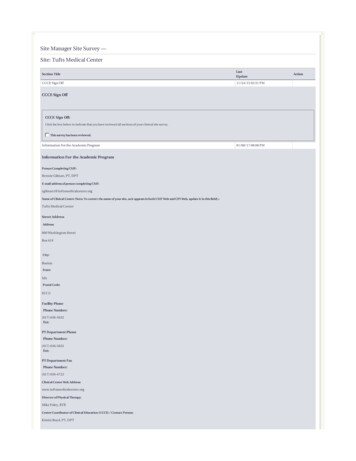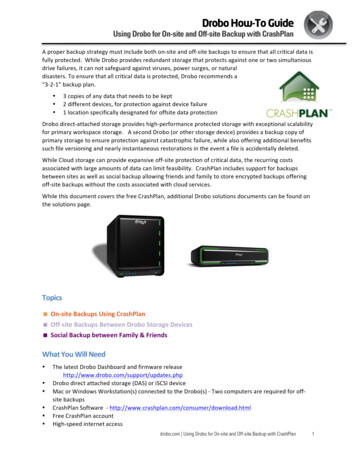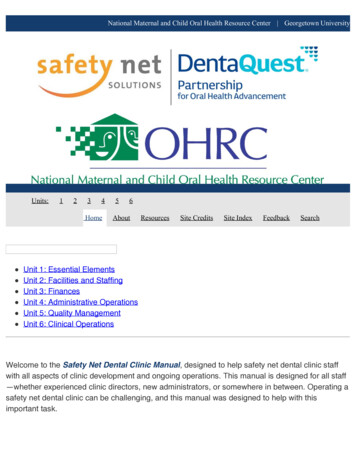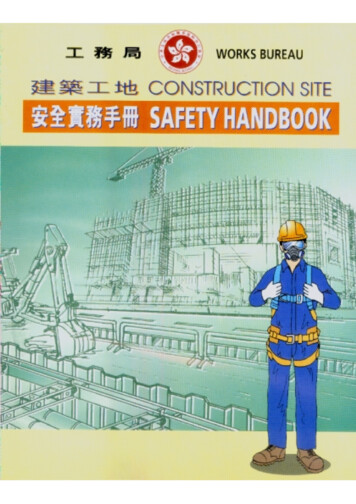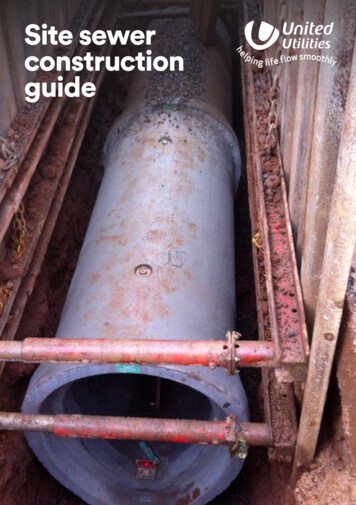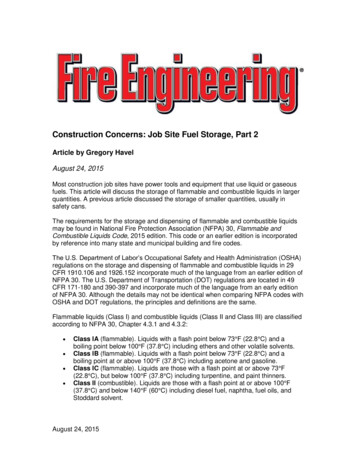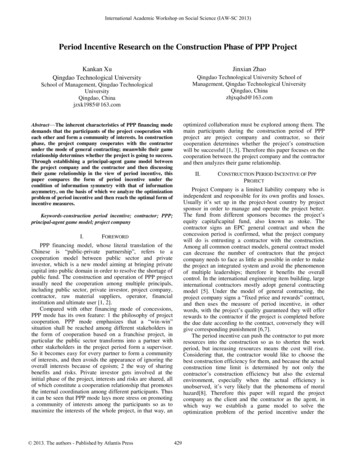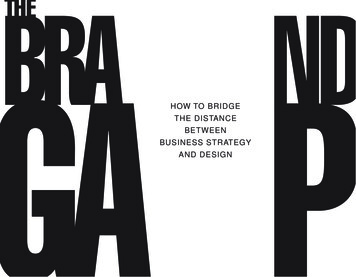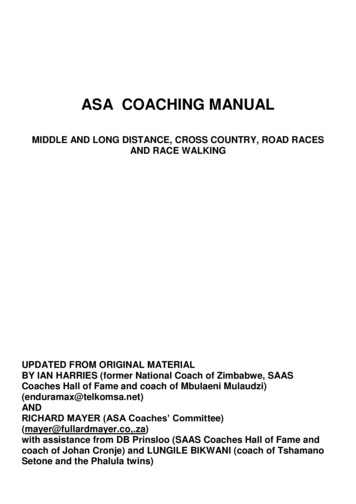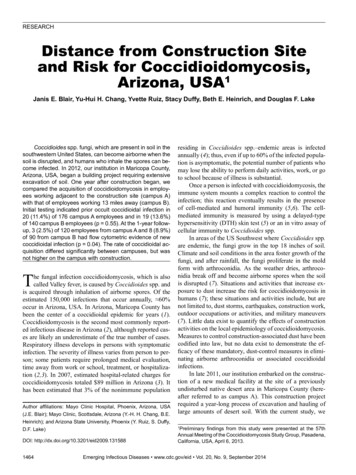
Transcription
RESEARCHDistance from Construction Siteand Risk for Coccidioidomycosis,Arizona, USA1Janis E. Blair, Yu-Hui H. Chang, Yvette Ruiz, Stacy Duffy, Beth E. Heinrich, and Douglas F. LakeCoccidioides spp. fungi, which are present in soil in thesouthwestern United States, can become airborne when thesoil is disrupted, and humans who inhale the spores can become infected. In 2012, our institution in Maricopa County,Arizona, USA, began a building project requiring extensiveexcavation of soil. One year after construction began, wecompared the acquisition of coccidioidomycosis in employees working adjacent to the construction site (campus A)with that of employees working 13 miles away (campus B).Initial testing indicated prior occult coccidioidal infection in20 (11.4%) of 176 campus A employees and in 19 (13.6%)of 140 campus B employees (p 0.55). At the 1-year followup, 3 (2.5%) of 120 employees from campus A and 8 (8.9%)of 90 from campus B had flow cytometric evidence of newcoccidioidal infection (p 0.04). The rate of coccidioidal acquisition differed significantly between campuses, but wasnot higher on the campus with construction.The fungal infection coccidioidomycosis, which is alsocalled Valley fever, is caused by Coccidioides spp. andis acquired through inhalation of airborne spores. Of theestimated 150,000 infections that occur annually, 60%occur in Arizona, USA. In Arizona, Maricopa County hasbeen the center of a coccidioidal epidemic for years (1).Coccidioidomycosis is the second most commonly reported infectious disease in Arizona (2), although reported cases are likely an underestimate of the true number of cases.Respiratory illness develops in persons with symptomaticinfection. The severity of illness varies from person to person; some patients require prolonged medical evaluation,time away from work or school, treatment, or hospitalization (2,3). In 2007, estimated hospital-related charges forcoccidioidomycosis totaled 89 million in Arizona (3). Ithas been estimated that 3% of the nonimmune populationAuthor affiliations: Mayo Clinic Hospital, Phoenix, Arizona, USA(J.E. Blair); Mayo Clinic, Scottsdale, Arizona (Y.-H. H. Chang, B.E.Heinrich); and Arizona State University, Phoenix (Y. Ruiz, S. Duffy,D.F. Lake)DOI: ng in Coccidioides spp.–endemic areas is infectedannually (4); thus, even if up to 60% of the infected population is asymptomatic, the potential number of patients whomay lose the ability to perform daily activities, work, or goto school because of illness is substantial.Once a person is infected with coccidioidomycosis, theimmune system mounts a complex reaction to control theinfection; this reaction eventually results in the presenceof cell-mediated and humoral immunity (5,6). The cellmediated immunity is measured by using a delayed-typehypersensitivity (DTH) skin test (5) or an in vitro assay ofcellular immunity to Coccidioides spp.In areas of the US Southwest where Coccidioides spp.are endemic, the fungi grow in the top 18 inches of soil.Climate and soil conditions in the area foster growth of thefungi, and after rainfall, the fungi proliferate in the moldform with arthroconidia. As the weather dries, arthroconidia break off and become airborne spores when the soilis disrupted (7). Situations and activities that increase exposure to dust increase the risk for coccidioidomycosis inhumans (7); these situations and activities include, but arenot limited to, dust storms, earthquakes, construction work,outdoor occupations or activities, and military maneuvers(7). Little data exist to quantify the effects of constructionactivities on the local epidemiology of coccidioidomycosis.Measures to control construction-associated dust have beencodified into law, but no data exist to demonstrate the efficacy of these mandatory, dust-control measures in eliminating airborne arthroconidia or associated coccidioidalinfections.In late 2011, our institution embarked on the construction of a new medical facility at the site of a previouslyundisturbed native desert area in Maricopa County (hereafter referred to as campus A). This construction projectrequired a year-long process of excavation and hauling oflarge amounts of desert soil. With the current study, wePreliminary findings from this study were presented at the 57thAnnual Meeting of the Coccidioidomycosis Study Group, Pasadena,California, USA, April 6, 2013.1Emerging Infectious Diseases www.cdc.gov/eid Vol. 20, No. 9, September 2014
Risk for Coccidioidomycosissought to quantify and compare the rate of acquisition ofcoccidioidomycosis among employees working at an existing facility on campus A with that among employees working at another campus 13 miles away (hereafter referred toas campus B).MethodsAfter approval was given by the Mayo Clinic Institutional Review Board, all employees at the 2 campuses wereinvited by email to participate in the study. Employeeswere included if they were 18 years of age, spent 95% oftheir work time on a single campus (A or B), and were selfreported to be immunocompetent. Exclusion criteria included the following: presence of any immunosuppressiveillness or medication (including seropositivity for HIV; history of hematologic malignancy; and receipt of cancer chemotherapy, antirejection medication, inhibitors of tumornecrosis factor, or other immunosuppressants); a history ofanergy to tests of DTH, unless subsequent skin test reactivity had been demonstrated; a history of coccidioidal illness(diagnosed by a physician or confirmed by skin testing orserologic, microbiologic, or pathologic evidence); a historyof positive results for coccidioidal serology or coccidioidalskin test; current use of an oral or intravenous antifungaldrug (azole or amphotericin) that could prevent coccidioidomycosis; or current pregnancy (because of a theoreticaldecrease in cellular immunity).During January 22–February 13, 2012, employeeswho provided verbal consent completed a questionnaire toascertain whether they met inclusion criteria and to provideadditional information, such as demographic information(sex, race/ethnicity, duration of residence in the Coccidioides spp.–endemic area, and residential zip code); the typesof regular outdoor activities they participated in; and anyperception they might have that construction was occurringnear their area of employment or residence. A 10-mL bloodsample was collected from each participant and assayed forcellular immunity to Coccidioides spp. All campus A participants were recruited and had a blood sample collectedbefore excavation and construction began. Campus B participants were recruited and tested within 2 weeks of construction onset. Twelve to 13 months later, during January29–March 27, 2013, we again collected and assayed bloodsamples from participants and administered a second questionnaire. Data were eliminated from analysis if a participant’s employment site changed from 1 campus to the otherafter enrollment.We used a whole-blood CD69 lymphocyte-activationassay to determine whether study participants were infected with Coccidioides fungi; the assay methods used weresimilar to previously described methods (8–10). In brief,we incubated 0.5 mL of whole peripheral blood with 5 μgof coccidioidin filtrate (provided by Mitch Magee, ArizonaState University, Tempe, AZ, USA) for 24 h at 37 C ina humidified incubator containing 5% CO2. Phytohemagglutinin lectin (5 µg) was used as a positive stimulatorycontrol, and 10 mL of phosphate-buffered saline (PBS)was added to the control tubes. After the 24-h incubation,we lysed the erythrocytes by using BD FACS lysing solution (Becton, Dickinson and Company, Franklin Lakes, NJ,USA) according to the manufacturer’s instructions. We resuspended the resultant peripheral blood mononuclear cell(PBMC) pellet in 200 mL of PBS and then added 20 mLeach of fluorescein–conjugated anti-CD3 and phycoerythrin-conjugated anti-CD69 antibodies (Becton, Dickinsonand Company). The antibodies and PBMCs were gentlymixed, incubated for 30 min at room temperature, and thenwashed twice with 3 mL of PBS. The final PBMC pelletwas resuspended in 500 mL of PBS and analyzed on a Becton Dickinson CyAn flow cytometer. Before each flow cytometry run, the instrument was calibrated according to themanufacturer’s protocol. Isotype controls for fluoresceinisothiocyanate–labeled and phycoerythrin-labeled CD3and CD69 antibodies were used to establish a CD3-positivecell gate. From that CD3-positive population, we quantifiedCD69-positive cell populations.For the initial assay in 2012, we classified test resultsfor all participants into 3 groups: definite negative (meanfluorescence intensity of CD69 above control; range 0%–5.9%), possibly negative (intermediate mean fluorescenceintensity; range 6.1%–8.1%), and definite positive (meanfluorescence intensity; range 9.4%–33.1%). On the basisof results from healthy controls with known or no knownhistory of definite coccidioidomycosis, we used 6.1% as acutoff for differentiating between study participants witha positive or a negative test result for coccidioidomycosis.For participants eligible for the second test in 2013, a similar process was undertaken.The percentage of employees who converted from anegative to a positive test result was calculated for eachstudy site and compared by using the χ2 test or the Fisherexact test, as applicable. For other employee characteristics,categorical variables were reported in numbers and percentages and compared by using the χ2 test or the Fisher exacttest; for the ages of participants, we reported the mediansand compared them by using the Wilcoxon rank sum test.After reviewing the results of our study, we conducteda logistic regression analysis, using only information collected in the initial questionnaire, to explore possible factorsassociated with conversion of cellular immunity. The univariate analysis was performed first, and any variables withp 0.30 were considered in the model-selection process.We used the backward elimination procedure to identifythe variables, and any variable with p 0.15 was retained inthe model. Since the comparison between employees fromdifferent campuses was of interest, campus location wasEmerging Infectious Diseases www.cdc.gov/eid Vol. 20, No. 9, September 20141465
RESEARCHretained in the model. These liberal criteria were used forthe exploratory purposes of our analysis. For the final model, adjusted odds ratios (ORs), 95% CIs, and p values werereported. All analyses were conducted by using SAS 9.2(SAS Institute Inc., Cary, NC, USA). All tests were 2-sided;p 0.05 was considered statistically significant.With regard to the construction, the medical institution’s Construction Safety and Infection Control policyrequired that the contractor develop a plan for using everyappropriate precaution to avoid or limit dust in the air andin adjacent buildings during construction. The plan included precautions compliant with the Maricopa County AirQuality Department specifications to limit dust pollution(11), including a dust control permit (11). Trained countyinspectors made periodic unannounced inspections of theconstruction site.Construction commenced in late January 2012, andmost of the excavation and movement of dirt was completed within 1 year. During that time, 15 unannounced inspections were conducted, and no violations of dust controlregulations were documented. In total, 154,600 cubic yardsof soil was excavated to a depth of 33 feet; pockets forconcrete and steel caissons were excavated another 40–90feet. The top 18 inches of soil was removed in the first 4months. All excavated soil was initially moved to on-sitestockpiles, but from the fourth month onward, 80% of thestockpiled soil was hauled off site; the balance of soil wasre-used on the construction site for backfill or for building up new parking lots or an electric substation. It is notknown when the movement of topsoil was completed orhow much of the original top 18 inches of soil was in thesoil that was re-used.ResultsIn January 2012, campus A employees were recruitedand enrolled in the study during the 2 weeks before onsetof the construction site excavation; campus B employeeswere enrolled 2 weeks later. A total of 316 employeesmet inclusion criteria: 176 from campus A and 140 fromcampus B. Of these employees, 20 (11.4%, 95% CI 6.7%–12.1%) from campus A and 19 (13.6%, 95% CI 7.9%–19.2%) from campus B were excluded because test resultsfor the CD69 lymphocyte–activation assay were positive,indicating previous coccidioidal infection and current immunity (p 0.55).The flow of study participation, from the beginning tothe end of the study, is summarized in Figure 1. After aninitial positive test result, making participants ineligible forthe second test a year later, the most common reasons forexclusion were employee attrition, change of employmentcampus, or medical leave (n 16 for campus A; n 14 forcampus B). A year after the study was initiated, campus Ahad 140 eligible employees available for participation, ofwhom 120 (85.7%) continued in the study, and campus Bhad 107, of whom 90 (84.1%) continued.At the 1-year follow-up, 3 (2.5%) of 120 participantsfrom campus A who had previously negative test resultshad lymphocyte proliferation evidence of newly acquiredFigure 1. Flowchart of studyparticipants in a study of theacquisition of immunity toCoccidioides spp. among personsworking adjacent to and 13 milesaway from a construction projectrequiring extensive excavation ofsoil, Arizona, USA, 2012–2013.1466Emerging Infectious Diseases www.cdc.gov/eid Vol. 20, No. 9, September 2014
Risk for Coccidioidomycosiscoccidioidal infection, compared with 8 (8.9%) of 90participants from campus B (p 0.04). Figure 2 shows testresults for representative study participants from each campus who showed immunologic conversion from negativefor coccidioidal infection in 2012 to positive in 2013.Table 1 summarizes the demographics, perceptions ofrisk for coccidioidomycosis, and outdoor activities of thestudy population. Campus B employees were older andmore likely to regularly walk outdoors than were campusA employees. At the 1-year follow-up, there was a disproportionate drop in male participants on campus B and anincrease in the proportion of participants on campus B whoreported construction activity near their homes. Table 2summarizes the comparison of demographic characteristicsand risk factors for coccidioidomycosis among participantswho did and those who did not show immunologic conversion after 1 year. Campus location and walking outdoors forrecreation were associated with conversion of cellular immunity. Participant variables, including age, participationin other (or any) outdoor activities, and residential zip code,were assessed by logistic regression, and did not correlatewith conversion of cellular immunity (data not shown).The final model, which evaluated factors associatedwith the conversion of cellular immunity, showed that participants on campus A, compared with those on campus B,had a lower odds of acquiring coccidioidal infection (adjusted OR 0.42, 95% CI 0.15–1.19; p 0.10). Regularly takingwalks outdoors was associated with increased odds of acquisition (adjusted OR 3.39, 95% CI 0.74–15.49; p 0.11).During the 1-year study period, 1 participant had aclinical episode consistent with new coccidioidal infection.This otherwise healthy 54-year-old woman experienced aninsidious onset of heart palpitations, dyspnea, cough, profound fatigue, and new back pain; chest imaging showedFigure 2. Serial flow cytometry images showing immunologic conversion from negative to positive for participants in a study of distancefrom a construction site as a risk factor for coccidioidomycosis, Arizona, USA, 2012–2013.Conversion was measured by using the CD69lymphocyte-activation assay. A, B) Images for a representative participant from campus A, which was adjacent to the construction site.C, D) Images for a representative participant from campus B, which was 13 miles from the construction site. A, C) Images were done in2012, before construction began. B, D) Images were done in 2013, a year after construction began. The participants’ CD3-positive T-cellpopulations are shown in the lower right quadrant of each image. The percentage of CD3/CD69-positive T cells changed from 1.9% to6.4% in the campus A participant and from 2.9% to 17.7% in the campus B participant. FITC, fluorescein isothiocyanate; PE, phycoerythrin.Emerging Infectious Diseases www.cdc.gov/eid Vol. 20, No. 9, September 20141467
RESEARCHTable 1. Characteristics of participants, at enrollment and 1 year later, in a study of distance from a construction site as a risk factor forcoccidioidomycosis, Arizona, USA, 2012–2013*At enrollment, n 316At 1-year follow-up, n 210CharacteristicCampus A†Campus B†p valueCampus A†Campus B†p valueSex0.03‡M28/176 (15.9)20/140 (14.3)0.69‡22/120 (18.3)7/90 (7.8)F148/176 (84.1) 120/140 (85.7)98/120 (81.7)83/90 (92.2)Median age, y (range)47 (21–75)53 (18–76)0.04§49 (23–72)53 (25–76)0.04§Race/ethnicity0.75‡White144/176 (81.8) 119/140 (85.0) 0.66‡101/120 (84.2)75/89 (84.3)Hispanic13/176 (7.4)10/140 (7.1)7/120 (5.8)7/89 (7.9)Other19/176 (10.8)11/140 (7.9)12/120 (10.0)7/89 (7.9)Indoor work location168/176 (95.5) 137/140 (97.9) 0.35‡117/119 (98.3)89/90 (98.9)0.67‡Work near a construction site77/168 (45.8)2/140 (1.4) 0.001‡86/114 (75.4)4/89 (4.5) 0.001‡Live near a construction site18/170 (10.6)6/135 (4.4)0.048‡17/120 (14.2)8/88 (9.1)0.27‡New home construction, remodeling,NANANA28/116 (24.1) 19/88 (21.6)0.67‡landscaping in home or neighborhoodsince enrollment¶Regular weekly participation in outdooractivities#Running26/176 (14.8)23/140 (16.4)0.69‡18/120 (15.0)9/90 (10.0)0.28‡Hiking52/176 (29.5)39/140 (27.9)0.74‡34/120 (28.3)20/90 (22.2)0.32‡Walking107/176 (60.8) 110/140 (78.6) 0.007‡72/120 (60.0)71/90 (78.9)0.004‡Yard work53/176 (30.1)53/140 (37.9)0.15‡37/120 (30.8)33/90 (36.7)0.37‡Received diagnosis of coccidioidomycosisNANANA1/117 (0.9)0 0.99**during study periodInitiated antifungal therapy afterNANANA1/120 (0.9)1/90 (1.1) 0.99**enrollment*Campus A was adjacent to and campus B was 13 miles away from the construction site, which required extensive excavation of soil inhabited byCoccidioides fungi. NA, not available.†Values are no. with characteristic/no. total (%), except as noted for age.‡By 2 test.§By Wilcoxon rank sum test.¶Work that took place within the past year.#Other activities that were evaluated but did not differ significantly between campuses were jogging, gardening, landscaping, golfing, playing team sports,swimming, and biking.**By Fisher exact test.a 12-mm solid pulmonary nodule with satellite lesionsthat were not present in a radiograph from 4 years earlier.The results of coccidioidal serologic testing were positiveby enzyme immunoassay for IgG and indeterminate forIgM; immunodiffusion was indeterminate for IgM. Thisparticipant received a clinical diagnosis of probable coccidioidomycosis; she recovered clinically and had negativecoccidioidal serology results within 6 months, without antifungal treatment. Results of her enrollment and follow-uplymphocyte activation studies were negative. During thestudy period, short-term ( 2 weeks’ duration) antifungaltreatments were administered to 2 other study participants(1 from each campus) for noncoccidioidal illnesses.DiscussionCoccidioidomycosis is a respiratory illness with a variety of clinical manifestations. Approximately two thirdsof infected persons are asymptomatic; the remainder showsigns and symptoms of systemic and respiratory illness thatrange from mild to severe and life threatening.Once a person is infected with Coccidioides fungi, theimmune system mounts a complex reaction to control theinfection; this reaction eventually results in the presenceof cell-mediated and humoral immunity (5,6). Persons who1468recover uneventfully from c
ton Dickinson CyAn flow cytometer. Before each flow cy-tometry run, the instrument was calibrated according to the manufacturer’s protocol. Isotype controls for fluorescein isothiocyanate–labeled and phycoerythrin-labeled CD3 and CD69 antibodies were used to establish a CD3-positive ce
